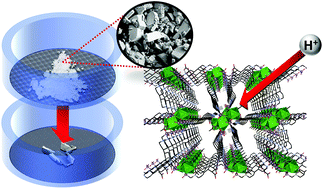Particle size dependence of proton conduction in a cationic lanthanum phosphonate MOF†
Abstract
A lanthanum(III) metal–organic framework, PCMOF21-AcO [La2(H2L)1.5(AcO)3·(H2O)5.59], with a 3-D network linked by dicationic bis(dimethylphosphonato)bipiperidinium units and both coordinated and free acetate counter anions is reported. PCMOF21-AcO was water stable and showed very good proton conductivity >10−3 S cm−1 at 85 °C and 95% relative humidity. PCMOF21-AcO also showed a bimodal particle size distribution and so proton conductivity was further examined as a function of particle size. Large (≥220 μm), intermediate (125 ≤ x < 180 μm) and small (<38 μm) particles were sieved and proton conductivity compared. The larger particle samples showed better proton conduction, an observation that supports grain boundaries being a hurdle to proton conduction rather than an enabler (e.g. by degradation routes enabling ion mobility). Proton conductivity as a function of pelletization pressure was also studied and affirmed that, for this system, the single semicircular feature observed in impedance analysis accounted for bulk and grain boundary contributions.

- This article is part of the themed collection: Inorganic Porous and Layered Material


 Please wait while we load your content...
Please wait while we load your content...